Treaty of June 22, 1825
The Treaty of June 22, 1825, established a formal relationship between the United States and the Teton, Yancton, and Yanctonies bands of the Sioux tribe. It aimed to reinforce friendship and regulate trade, acknowledging U.S. supremacy and protection. The treaty outlined terms for trade, mutual protection, conflict resolution, and prohibited the sale of arms to unfriendly tribes. Chiefs agreed to deliver individuals for justice and protect U.S. representatives. The agreement signifies a commitment to ongoing cooperation and peace between the parties involved.


